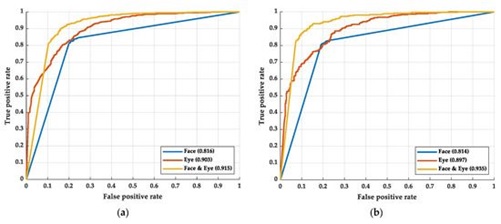Drowsiness Detection System in Real Time Based on Behavioral Characteristics of Driver using Machine Learning Approach

DOI:
https://doi.org/10.54060/jieee.v4i1.84Keywords:
Drowsiness detection, Real-time detection, OpenCV, Dlib, Facial landmark detection, Driver safety, Machine LearningAbstract
The process of determining if a person, generally a driver, is becoming sleepy or drowsy while performing a task such as driving is known as drowsiness detection. It is a necessary system for detecting and alerting drivers to their tiredness, which might impair their driving ability and lead to accidents. The project aims to create a reliable and efficient system capable of real-time detection of drowsiness using OpenCV, Dlib, and facial landmark detection technologies. The project's results show that the sleepiness detection method can accurately and precisely identify tiredness in real time. The technology is less intrusive and more economical than conventional sleepiness detection techniques. The system is based on a 68 facial landmark detector, which is a highly trained and effective detector capable of recognizing human face points. The detector aids in assessing whether the driver's eyes are closed or open. The system analyses the data collected by the detector using machine learning methods to discover patterns associated with drowsiness. When drowsiness is detected, the system incorporates a warning mechanism, such as an alarm or a vibration in the steering wheel, to notify the driver. A variety of studies with different drivers and driving conditions were used to evaluate the performance of the real-time driver drowsiness detection system. The results show that the technology can detect tiredness properly and deliver timely warnings to the driver. This method can assist in preventing drowsy driving incidents, enhancing road safety, and saving lives. The results indicated that the algorithm had an average accuracy rate of 94% for identifying tiredness in drivers.
Downloads
References
L. Tang, J. Zheng, and J. Hu, “A numerical investigation of factors affecting lumbar spine injuries in frontal crashes,” Accid. Anal. Prev., vol. 136, no. 105400, 2020. Link: https://doi.org/10.1016/j.aap.2019.105400
M. Ramzan, H. U. Khan, S. M. Awan, A. Ismail, M. Ilyas and A. Mahmood, "A Survey on State-of-the-Art Drowsiness Detection Techniques," in IEEE Access, vol. 7, pp. 61904-61919, 2019, doi: 10.1109/ACCESS.2019.2914373.
H. K. Dua, S. Goel and V. Sharma, "Drowsiness Detection and Alert System," 2018 International Conference on Advances in Computing, Communication Control and Networking (ICACCCN), Greater Noida, India, 2018, pp. 621-624, doi: 10.1109/ICACCCN.2018.8748448.
W. Deng and R. Wu, "Real-Time Driver-Drowsiness Detection System Using Facial Features," in IEEE Access, vol. 7, pp. 118727-118738, 2019, doi: 10.1109/ACCESS.2019.2936663.
K. Satish, A. Lalitesh, K. Bhargavi, M. S. Prem and T. Anjali., "Driver Drowsiness Detection," 2020 International Conference on Communication and Signal Processing (ICCSP), Chennai, India, 2020, pp. 0380-0384, doi: 10.1109/ICCSP48568.2020.9182237.
N. Prasath, J. Sreemathy and P. Vigneshwaran, "Driver Drowsiness Detection Using Machine Learning Algorithm," 2022 8th International Conference on Advanced Computing and Communication Systems (ICACCS), Coimbatore, India, 2022, pp. 01-05, doi: 10.1109/ICACCS54159.2022.9785167.
P. Anjana, J. Johny, S. Shilpa, and V. K. Govindan, “Drowsiness Detection System using Eye Blink and Yawn Recognition Techniques,” International Journal of Advanced Research in Computer Science and Software Engineering, vol. 8, no. 7, pp. 437–441, 2018.
M. Narejo, “Drowsy Driver Detection System Using Machine Learning Techniques,” International Journal of Advanced Computer Science and Applications, vol. 10, no. 7, pp. 202–206, 2019.
C. Ryan et al., “Real-time face & eye tracking and blink detection using event cameras,” Neural Netw., vol. 141, pp. 87–97, 2021.
N. Behrooz, and M. Moazzami. "Drowsiness detection using machine learning algorithms: a comprehensive review." International Journal of Intelligent Transportation Systems Research, vol. 16, no. 4, pp. 159-172, 2018.
J. Kim, H. Kim, and H. J. Kim, “Drowsiness detection based on facial landmarks and eye status using convolutional neural network,” Sensors, vol. 19, no. 2, p. 362, Jan. 2019, doi: 10.3390/s19020362.
Y. Chen, W. Shi, W. Zhang, and J. Lu, "A robust real-time driver drowsiness detection system using eye aspect ratio and facial landmarks," in 2018 37th Chinese Control Conference (CCC), Jul. 2018, pp. 10635-10640.
G. Srivastava and S. Singh, “A comparative analysis on machine learning techniques for driver distraction detection,” in Lecture Notes in Electrical Engineering, Singapore: Springer Nature Singapore, 2023, pp. 411–422. https://doi.org/10.1007/978-981-19-9876-8_31
P. P. Patel, C. L. Pavesha, S. S. Sabat and S. S. More, "Deep Learning based Driver Drowsiness Detection," 2022 International Conference on Applied Artificial Intelligence and Computing (ICAAIC), Salem, India, 2022, pp. 380-386, doi: 10.1109/ICAAIC53929.2022.9793253.
R. Pawar, S. Wamburkar, R. Deshmukh and N. Awalkar, "Driver Drowsiness Detection Using Deep Learning," 2021 2nd Global Conference for Advancement in Technology (GCAT), Bangalore, India, 2021, pp. 1-7, doi: 10.1109/GCAT52182.2021.9587519.
M. Elham Walizad, M. Hurroo and D. Sethia, "Driver Drowsiness Detection System using Convolutional Neural Network," 2022 6th International Conference on Trends in Electronics and Informatics (ICOEI), Tirunelveli, India, 2022, pp. 1073-1080, doi: 10.1109/ICOEI53556.2022.9777182.

Downloads
Published
How to Cite
CITATION COUNT
License
Copyright (c) 2023 Gauri Adarsh, Vineet Singh, Dr Shikha Singh, Dr Bramah Hazela

This work is licensed under a Creative Commons Attribution 4.0 International License.

























